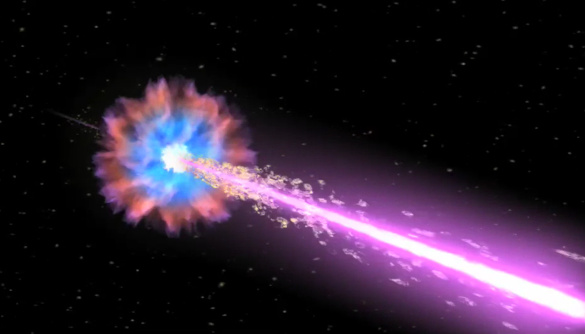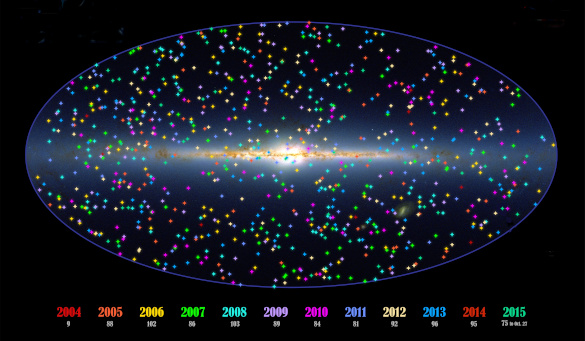GRB Extinctions
May 17, 2021
It's difficult to find a
science fiction film that doesn't have
human extinction as its
narrative, typically by
meteor impact or
nuclear war. One that's not among these many
B-movies is the 2008 film,
The Day the Earth Stood Still.[1] It has
self-replicating machines unleashed to turn humans into
gray goo.
A
gamma-ray burst (GRB) is far more
efficient at destroying human life than
Godzilla[2] and
Skynet[3].
Diaspora, a 1997 science fiction
novel by
Greg Egan (b. 1961) imagines a GRB destroying the
atmosphere of a
future Earth leading to mass
extinction.[4] While the novel is
fiction, the
possibility of such an event is very real, but fortunately very small. The
probability is small, since we live in a low
density region at the outskirts of our
Milky Way Galaxy.

Artist's conception of a gamma-ray burst. Initially, a narrow beam (white) of gamma rays is emitted, followed by a wider beam (purple). (Still frame from a NASA/Swift/Cruz deWilde animation. Click for larger image.)
Although
satellite observatories detect about one GRB each day, all these originate outside the Milky Way galaxy and they pose no
danger. Closer to Earth, GRBs that have a potential to affect
life on Earth occur about once every five million years. That means that life on Earth has experienced their affects about eight hundred times. The
Ordovician–Silurian extinction events in which 85% of
marine species were
extinguished about 450 million years ago may have been caused by a GRB.
Earth has been hit by
radiation from three intense GRBs in
this century. The first, on December 27, 2004, was from
SGR 1806-20 at 50,000
light year's distance.[5-6] This GRB
ionized Earth's atmosphere down to about 50,000
feet (20
kilometers), nearly down to the level of
commercial aircraft.[5-6] This gamma ray event increased the density of ions at a 60 kilometer altitude by a huge factor, from 0.1 to 10,000 free
electrons per
cubic foot.[6]
On April 27, 2013, Earth was assaulted by another intense gamma ray burst, designated
GRB 130427A at a distance of about 3.8 billion
light years.[7] This gamma ray event had an
intensity reaching 95 billion
electron volts (eV).[7] For comparison purposes,
thermal energy (k
BT) at
room temperature is about 0.025 eV. Fortunately, the radiation from this burster was easily absorbed by Earth's atmosphere.
An associated
optical flash from GRB 130427A was strong enough to be observed with
binoculars, and its position was nearly coincident with a
galaxy designated SDSS J113232.84+274155.4. A burst comparable to GRB 130427A has a probability of less than 1 in 10 million of occurring in
our galaxy.[7] The most recent energetic GRB, named
GRB 190114C, was in November 2019. This GRB produced gamma-rays with the highest energy ever observed, about a
tera (10
12) electron volts.[8]
In the
1950s,
physicist,
Enrico Fermi (1901-1954), wondered why there is no
evidence of an
extraterrestrial civilization when he asked during
luncheon conversation at
Los Alamos National Laboratory, "Where are they?" In our Milky Way Galaxy, there should be many civilizations much more advanced than we are, and these could at least have sent
automated exploratory spacecraft our way. This problem is known as the
Fermi paradox, and one
conjectured reason for the absence of
space aliens is that GRBs eventually destroy these civilizations.

Extraterrestrials might be hesitant to visit us when they could potentially expect a reception like this.
(A color-modified Wikimedia Commons image from the Open Clipart Library, traced from Captain Science #5, art by Joe Orlando and Wally Wood.)
The high probability (95%) of
lethal bursts within four
kiloparsecs (kpc) of our
galactic center makes that region
inhospitable to life.[9] Only at the periphery of the Milky Way, more than 10 kpc from the center, does the probability of life-extinguishing bursts drop below 50%.[9] The Milky Way Galaxy will experience a 10
40 eV gamma ray burst about every billion years, and smaller bursts occur more often.[11] Gamma ray bursts would have prevented life in nearly every galaxy formed in the first five billion years of the
universe, and the The Milky Way could be among only 10% of all galaxies that can sustain
complex life for a considerable period.[11]
A team of
Italian astronomers has recently concluded that until about six billion years ago the region at the outskirts of the Milky Way was the
safest place for the development life, since it was relatively sheltered from
supernova explosions and gamma-ray bursts.[12-13]. In the last about four billion years, this safe region shifted to between 2 and 8 kpc from the center.[12] The research team had members from the
Università dell'Insubria (Como, Italy), the
Osservatorio Astronomico di Brera (Merate, Italy),
INFN Sezione Milano–Bicocca (Milano, Italy), and the
Università Milano–Bicocca, (Milano, Italy).[12-13] Their analysis is published in
Astronomy & Astrophysics.[12]

The first thousand gamma ray bursts (GRBs) detected by NASA's Swift observatory. The plane of our Milky Way Galaxy runs across the center. The GRBs are color coded by year. (NASA image from the Goddard Space Flight Center and the Two Micron All-Sky Survey/J. Carpenter, T. H. Jarrett, and R. Hurt (modified). Click for larger image.)
The
researchers developed a model of
habitability over time as a
function of the location from the galactic center of transient
astrophysical events (GRBs and supernova explosions).[12] The model shows a high probability that such events are abundant around certain
star types.[12] At our
Solar System's distance from the galactic center, the model estimates that there has been at least one lethal GRB in the last 500 million years, so it's consistent with the
hypothesis that a GRB caused the Ordovician–Silurian extinction about 450 million years ago.[12-13] The reassuring conclusion for us is that "the worst seems to be over."[13]
As study
co-author,
Giancarlo Ghirlanda, of the INAF explains,
"Supernovae are more frequent in star-forming regions, where massive stars are formed... GRBs, on the other hand, prefer star-forming regions that are still poorly engulfed by heavy elements. In these regions, massive stars that are formed by metal-poor gas lose less mass during their life due to stellar winds. Therefore, these stars are able to keep themselves in rapid rotation, a necessary condition to be able to launch, once a black hole has formed, a powerful jet."[13]
A supernova emits as much energy as the entire Milky Way emits in a few
hours, and a GRB emits in 10 seconds what the Milky Way emits in a
century.[13] A GRB within 3300 light years of Earth would destroy our planet's
ozone layer, expose
surface organisms to the
Sun's ultraviolet radiation to cause their extinction.[3] It would also produce
nitrogen compounds in the atmosphere that would reduce
insolation and cause
global cooling.[13]
References:
- The Day the Earth Stood Still, 2008, Scott Derrickson, Director, at the Internet Movie Database.
- Godzilla: King of the Monsters!, 1956, Ishiro Honda and Terry Morse, Directors, at the Internet Movie Database.
- The Terminator, 1984, James Cameron, Director, at the Internet Movie Database.
- Greg Egan, Diaspora, (Night Shade, Reprint edition, January 6, 2015), ISBN 978-1597805421, 352 pp. (via Amazon).
- Gamma-ray Burst Effects on the Ionosphere, Stanford University VLF Web Site.
- Dawn Levy, "Big gamma-ray flare from star disturbs Earth's ionosphere," Stanford Report, March 1, 2006.
- M. Ackermann and 181 Other Authors, "Fermi-LAT Observations of the Gamma-Ray Burst GRB 130427A," Science, vol. 343 no. 6166 (January 3, 2014), pp. 42-47, DOI: 10.1126/science.1242353.
- Bing Zhang, "Extreme emission seen from γ-ray bursts," Nature, vol. 575 November 20, 2019), pp. 448-449,doi: https://doi.org/10.1038/d41586-019-03503-6.
- Tsvi Piran and Raul Jimenez, "Possible Role of Gamma Ray Bursts on Life Extinction in the Universe," Phys. Rev. Lett., vol. 113, Document No. 231102 (December 5, 2014), DOI: http://dx.doi.org/10.1103/PhysRevLett.113.231102. An arXiv preprint is available here.
- Michael Schirber, "Focus: Gamma-Ray Bursts Determine Potential Locations for Life," Physics, vol. 7, no. 124 (December 8, 2014), DOI: 10.1103/Physics.7.124.
- Marc Türler, "Gamma-ray bursts are a real threat to life," CERN Courier, Jan 27, 2015.
- R. Spinelli, G. Ghirlanda, F. Haardt, G. Ghisellini, and G. Scuderi, "The best place and time to live in the Milky Way," Astronomy & Astrophysics, vol. 647 (March 5, 2021), Article no. A41, 11 pages, https://doi.org/10.1051/0004-6361/202039507. This is an open access publication with a PDF file here.
- The best place and time to live in the Milky Way, Istituto Nazionale di Astrofisica (INAF) Press Release, March 5, 2021.
Linked Keywords: Science fiction; film; human extinction; narrative; impact event; meteor impact; nuclear war; B-movie; The Day the Earth Stood Still (2008 film); self-replicating machine; gray goo; gamma-ray burst; efficiency; efficient; Godzilla; Skynet (Terminator); Diaspora (novel); Greg Egan (b. 1961); atmosphere of Earth; future; Earth; extinction; fiction; possibility; probability; number density; Milky Way Galaxy; Artist's impression; Artist's conception; light beam; gamma ray; emissivity; emit; film frame; Still frame; space telescope; satellite observatory; hazard; danger; earliest known life forms; life on Earth; Ordovician–Silurian extinction events; ocean; marine; species; extinguish; electromagnetic radiation; 21st century; this century; SGR 1806-20; light year; distance; ionization; ionize; foot (unit); kilometer; commercial aviation; commercial aircraft; electron; cubic foot; GRB 130427A; intensity (physics); electronvolt; electron volts; thermal energy; room temperature; visible-light astronomy; optical flash; binoculars; galaxy; Milky Way; our galaxy; GRB 190114C; tera; 1950s; physicist; Enrico Fermi (1901-1954); evidence; extraterrestrial civilization; lunch; luncheon; conversation; Los Alamos National Laboratory; automation; automated; exploration; exploratory; spacecraft; Fermi paradox; conjecture; space alien; extraterrestrials; first contact (science fiction); reception; Wikimedia Commons; Open Clipart Library; lethal dose; kiloparsecs; galactic center; habitable zone; inhospitable; universe; domplexity; complex; Italy; Italian; astronomer; safety; safe; safest; supernova explosion; University of Insubria; Università dell'Insubria (Como, Italy); Brera Astronomical Observatory; Osservatorio Astronomico di Brera (Merate, Italy); INFN Sezione Milano–Bicocca (Milano, Italy); University of Milano-Bicocca; Università Milano–Bicocca, (Milano, Italy); Astronomy & Astrophysics; The first 1000 GRBs detected by NASA's Swift spacecraft; NASA's Swift observatory; galactic plane; Goddard Space Flight Center; Two Micron All-Sky Survey; research; researchers; planetary habitability; function (mathematics); astrophysics; astrophysical; stellar classification; star type; Solar System; hypothesis; co-author; Giancarlo Ghirlanda; heavy metal; heavy element; metallicity; metal-poor; gas; stellar wind; rotation; black hole; astrophysical jet; hour; century; ozone layer; lithosphere; surface; organism; Sun; ultraviolet radiation; nitrogen compound; insolation; global cooling; The Day the Earth Stood Still (2008); Godzilla: King of the Monsters! (1956); The Terminator (1984); Internet Movie Database.